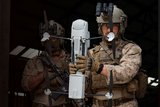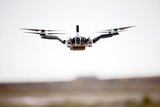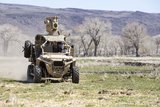TiaLinx announces launch of Phoenix40-A mini-UAV
TiaLinx, Inc., a developer of remotely controlled mini-unmanned aerial and ground vehicles integrated with mm-wave miniaturized radars, today announced the launch of the Phoenix40-A. The mini-UAV system is capable of performing dual functions as a motion detector as well as probing for breathing of a hiding person in a compound. The mini-UAV can be remotely controlled at long standoff distances from ground or an airborne asset.
The lightweight and agile mini-UAV with programmability to fly to or land at multiple waypoints has been integrated with TiaLinx's fine beam ultra-wideband (UWB), multi-Gigahertz radio frequency (RF) sensor array. The system provides long standoff surveillance of a premise to track movement as well as to detect motionless live objects. TiaLinx's real-time UWB RF Imaging development was sponsored by a SBIR Phase II from the Army's PEO AMMO, PM-CCS.
Through a software-controlled interface which is integrated into a laptop or joystick controller unit, Phoenix40-A can be remotely guided from long distances to perform mission critical tasks. In addition to the programmed GPS guided multi-waypoint visits, the integrated video cameras allow for day and night landing and monitoring of a premise under surveillance for enhanced situational awareness. Capability to probe a compound at standoff keeps the operator and the Phoenix40-A out of harm's way.
The RF Scanner is mounted on a lightweight mini-UAV and transmits wideband signals that are highly directional and can penetrate reinforced concrete wall at an extended range. In the receiver, a signal detector circuit is employed to capture the reflections from targets. Amplitude and delay information are then processed in an integrated signal processor.
"Phoenix40-A's introduction is intended to provide another breakthrough in miniaturization of advanced life detection sensors that provide the capability to sense-through-the-wall (STTW) remotely. Like its sister product Cougar20-H that was launched last month, Phoenix40-A can also be remotely programmed to survey a compound at multiple way points. It can scan a multi-story building and provide its layout. It is also capable of scanning in-road and off-road horizontally to detect buried unexploded ordnance (UXO)," commented Dr. Fred Mohamadi, Founder and CEO of TiaLinx. "TiaLinx is constantly miniaturizing and upscaling its UWB RF imaging core competence to enable standoff sensing of a premise for enhanced situational awareness, to assist rescue operations in hard-to-reach terrains such as collapsed buildings after an earthquake, and to eradicate land mines to save lives."
Source: TiaLinx
More from Uncrewed Vehicles
-
![Cummings Aerospace showcases Hellhound loitering munition designed for US Army’s LASSO programme (video)]()
Cummings Aerospace showcases Hellhound loitering munition designed for US Army’s LASSO programme (video)
Cummings Aerospace presented its turbojet-powered Hellhound loitering munition at SOF Week 2025, offering a man-portable solution aligned with the US Army’s LASSO requirements.
-
![SOF Week 2025: PDW unveils attritable FPV drone for SOF operations at scale]()
SOF Week 2025: PDW unveils attritable FPV drone for SOF operations at scale
PDW has revealed its Attritable Multirotor First Person View drone at SOF Week 2025, offering special operations forces a low-cost, rapidly deployable platform for strike and ISR missions, inspired by battlefield lessons from Ukraine.
-
![SOF Week 2025: Teledyne FLIR white paper provides guidance on reusable loitering munitions]()
SOF Week 2025: Teledyne FLIR white paper provides guidance on reusable loitering munitions
Teledyne FLIR is highlighting the emerging requirements for 'recoverable and re-usable' loitering munitions across the contemporary operating environment during this week’s SOF Week conference in Tampa, Florida.
-
![SOF Week 2025: Kraken Technology group debuts K3 Scout USV in North America]()
SOF Week 2025: Kraken Technology group debuts K3 Scout USV in North America
High-performance maritime industry player Kraken Technology Group, based in the UK, has used the SOF Week conference in Tampa, Florida this week to debut its K3 Scout uncrewed surface vessel (USV) to the North American market.
-
![Palladyne AI and Red Cat to demonstrate capabilities for autonomous drone swarms to the US military]()
Palladyne AI and Red Cat to demonstrate capabilities for autonomous drone swarms to the US military
Red Cat and Palladyne AI recently conducted a cross-platform collaborative flight involving three diverse heterogeneous drones.
-
Jammer resistant drone designs spark search for countermeasures
The Russia-Ukraine conflict has driven another stage of evolution for drones and the counter measures to defend against them.

























